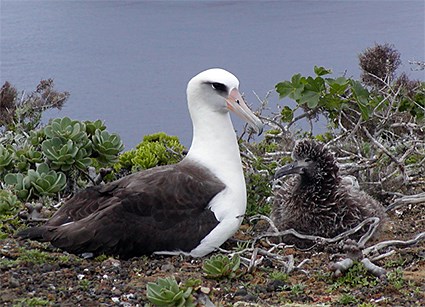Laysan Albatross
Kauai, Hawaii
Nest is located at a private residence on the north shore of Kauai, near the town of Kilauea, Hawaii. This albatross family includes: Kaluahine, the mother; Kaluakane, the father; and Kaloakulua, the chick. What do their names mean? Kaluakane and Kaluahine are the names given to the male and female albatross, respectively, by Sabra Kauka, a native Hawaiian kumu, or teacher. Ms. Kauka said she chose the names carefully to reflect the place where the birds chose to nest, as place seems to be such an important aspect to these long-lived birds. The nest site is in an area called Waiakalua, which means “fresh water of two streams.” In Hawaiian, the two streams (“kalua”) also signify two paths or two parts, she said. The endings “kane” and “hine” mean boy and girl, or male and female, respectively. Ms. Kauka named the chick "Kaloakulua," after the phase of the moon under which it hatched.
webcam link:
http://cams.allaboutbirds.org/channel/41/Laysan_Albatross/Laysan Albatrosses are very large seabirds, though they are actually fairly small for an albatross. They are about 2.5 feet long with a wingspan of nearly 7 feet. They can weigh up to 10 pounds. Laysan Albatrosses eat mostly squid that they catch by plunging their heads underwater as they sit on the surface. They also eat fish eggs, floating carrion, and sometimes discards from fishing boats. Adults digest food in their stomachs and then feed their chicks large amounts of nutritious stomach oil. How far do they travel to find food? The farthest-known single foraging trip for a Laysan Albatross feeding its chick was 1,600 miles (straight-line distance). Albatrosses belong to a group of birds known as tubenoses; the group also includes petrels, shearwaters, fulmars, storm-petrels, and diving-petrels. They have a special salt gland in their head that extracts excess salt from their blood and excretes it through a pair of bony tubes in the bill. This remarkable adaptation allows tubenoses to drink seawater without becoming dehydrated.
Laysan Albatrosses form very long-lasting pair bonds. A pair that has nested successfully at least once is very likely to remain together unless one member of the pair dies. Although they are banded, we don’t know exactly how old Kaluakane and Kaluahine are because they were banded as adults. They are at least nine years old. They have been together for at least two years, although their nest last year was not successful. Raising a chick takes almost nine months from laying to fledging. Raising a chick is so demanding that there’s a real benefit to a pair to having reliable timing and foraging success. Their elaborate courtship dances help to establish and maintain these very long and strong pair bonds. Laysan Albatrosses take a long time to begin breeding. Young birds first return to a breeding colony when they are 3-5 years old. Over the next few years they’ll learn how to court, look for a mate, and begin nesting. Typically, they are not successful until they are 8 (males) or 9 (females) years old.